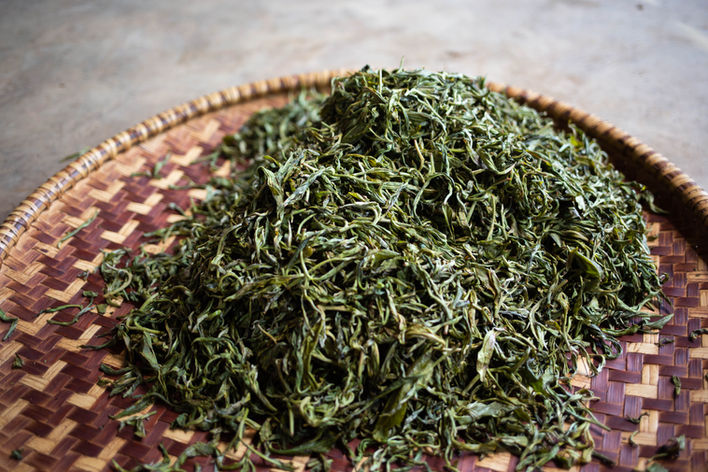
תה פואר
תה מורכב המגיע אלינו מהמרחבים האינסופיים של מחוז יונאן בדרום מערב סין, האזור בו מעריכים כי נתגלה לראשונה צמח הקמיליה סיננזיס. תה עוצמתי בעל השפעה פונקציונאלית ניכרת על גוף האדם בהשוואה לסוגי תה אחרים, הזוכה לאזכורים רבים ברפואה הסינית. תה פואר הוא שם מודרני, הנקרא על שמה של עיירת תה בתת-מחוז מנגהאי ביונאן, ומתחלק לשתי משפחות: פואר בהיר (ירוק) ופואר כהה (שחור).
שנג פואר (פואר בהיר)
הגרסה המקורית של תה פואר, raw pu'er 生普洱, שבמוקדים רבים ברחבי יונאן מופק עד היום בשיטות מסורתיות ע״י שבטים וקבוצות אתניות שונות. מעריכים כי פואר בהיר הוא התה הקדום ביותר שקיים היום, הקרוב ביותר לתה שהופק בעבר. אופן הפקת התה הפשוטה כביכול, דומה להליך הפקתו של תה ירוק, תה בעל היסטוריה מפוארת משל עצמו. ההבדל המהותי הוא באופן הטבעי והמעודן בו מיובשים עלי הפואר, המותיר אחוז נמוך של לחות ואינזימים בעלים, שיחד מאפשרים הליך איטי של תסיסה המשנה את ההרכב הכימי של העלים, מאריכה את חיי המדף של התה ומשביחה אותו עם הזמן. התוצאה היא ״פואר בהיר מיושן״ אשר עליו הכהו לגווניים כהים המפיקים משקה בוגר ומורכב יותר. האיכות והנדירות של פואר מקורי מיושן היטב עשויות להציב אותו ברמת יוקרה יוצאת דופן וערכו יכול להגיע לסכומי עתק.
שו פואר (פואר כהה)
שו פואר הוא הגרסה המאוחרת של תה פואר, ripe pu'er 熟普洱, היא תוצאה של מיסוד, או תיעוש מודרני של שיטות פוסט תסיסה של עלי תה שהיו קיימות באזורי גידול שונים בסין במשך מאות שנים, המוכר ביותר הוא התה הסיני השחור hei cha 黑茶 ממחוז חונאן. אותה בשורה בשנות ה-70 של המאה ה-20, אז החלו להפיק תה באופן מסחרי במחוז יונאן, תבעה גם את המונח ״פואר״, על שם אותה עיירת תה ידועה העונה לאותו השם.
מדובר באותם עלי שנג פואר בהירים העוברים הליך נוסף של ״תסיסה מזורזת״ בתנאיי לחות וחום מבוקרים. התוצאה היא מסע בזמן, עלי פואר צעירים כהים ומעובשים, שנראים כאילו תססו להם בנחת שנים רבות. מה שכנראה היווה מקור לזיופים הפך למשפחת תה מן השורה, עם סגולות רפואיות ייחודיות, בראשם חימום הגוף, סיוע למערכת העיכול וזרימת הדם. כיום שו פואר נחשב לתה הסיני המועדף ע״י זרים, ככל הנראה בשל אופיו החזק וטעמיו הדומיננטיים אשר מותאמים יותר לחך המערבי.
אזורי הגידול

יונגדה
יונאן
ש׳ישואנגבאנה
יונאן
לינצאנג
הפואר שלנו
היצע הפואר שלנו מגיע מחוות גידול פרטיות במספר כפרים לאורך דרום ומערב יונאן, ומהווה את הנתח הגדול ביותר באוסף התה המהודק שלנו. החיפוש אחר סוגי פואר אותנטיים וייחודיים הפך לאחד מתחומי המיקוד העיקריים שלנו בחקר התה הסיני. מסע החיפוש והנבירה בין סוגי הפואר השונים אשר גדלים ומופקים בתנאי terroir שונים, מניבים בכל עונה תה שונה ומאתגר היורד לפרטים וניואנסים אשר הופכים את הסורסינג של שנג פואר למשימה הרפתקנית שלעולם לא נגמרת.
אנו ממשיכים לכתת רגליים ולהרחיב את היצע הספקים המקומי שלנו בכל ביקור במחוז התה האהוב עלינו, לעקוב וללוות את גידול התה משלב הקטיף והמיון הראשוני (מאו צ׳ה) בכדי לבחור בעצמנו את חומר הגלם המועדף עלינו ביותר מתוך מאות גרסאות שונות. רק כך אנו מצליחים בכל שנה להביא מקבץ מזוקק של הפוארים האהובים עלינו ביותר, לאחר שעברו בדיקות מחמירות במעבדת Eurofins בטאיוואן, נארזו בקפידה בחומרים ידידותיים לסביבה ונשמרו במחסן שלנו בתנאים ייעודיים להשבחה של תה.
אוסף הפואר שלנו כולל גרסאות שונות של שו פואר ושנג פואר, צעירים ומיושנים משנות קטיף שונות, אותם אנו מיישנים בעצמנו במחסן ייעודי ובתנאים אופטימליים להשבחה של התה בצורתו המקורית. אנו נוהגים במשנה זהירות ובאחריות יתרה כאשר מדובר בשו פואר, שנחשב היום לתה הרגיש ביותר בתעשיית התה בשל השימוש בפטריות בהפקתו ומקרים לא מעטים של רשלנות וזיופים בהפקתו. מלבד הבדיקות המחמירות שכל תה עובר, אנו לא עובדים כלל עם תה מתועש שמגיע ממפעלים, אלא אך ורק עם חומר גלם מוכר מאותן חוות פרטיות אשר מייחסות חשיבות רבה לחומר הגלם ממנו מופק הפואר הכהה. התוצאה היא היצע מצומצם של גרסאות בוטיק נדירות ובלעדיות ל- ho yum tea, של תה מקורי ממקור ראשון, בטוח לשתייה.




























